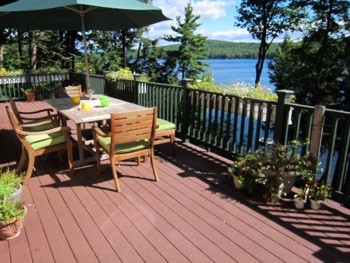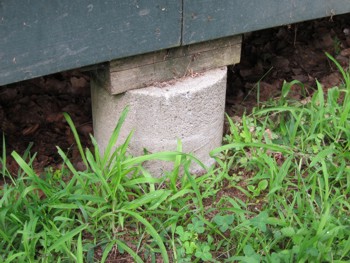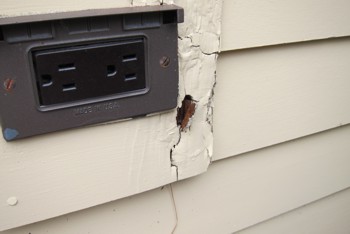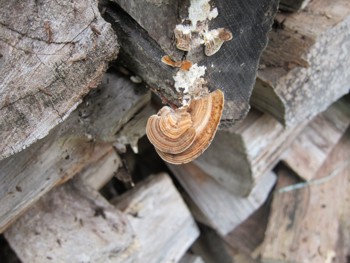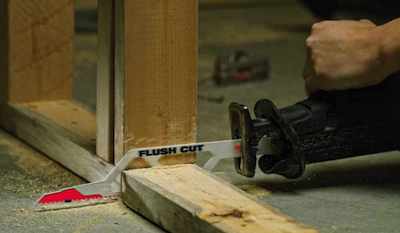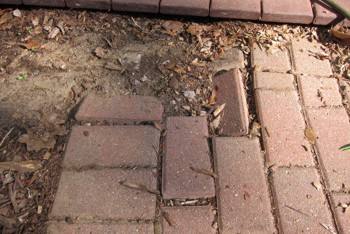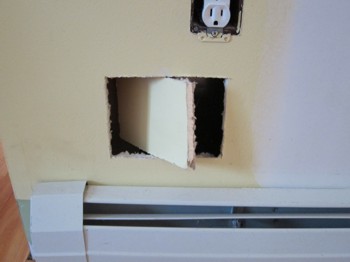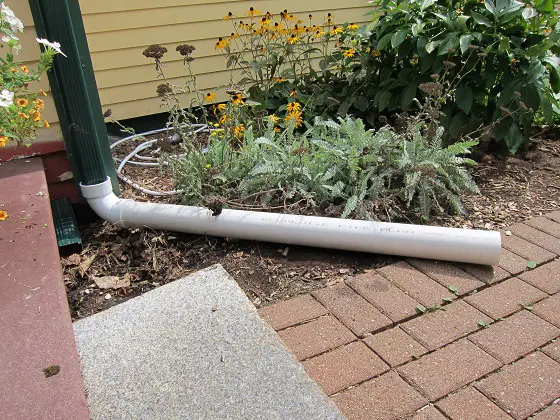
This downspout diverter was hastily placed to get the roof water onto the sidewalk where it will drain away from the house. It will later be replaced and piped underground. © 2017 Tim Carter
"Storms produce vast quantities of water on roofs. An average-sized ranch home that has a roof area close to 2,400 square feet will generate nearly 200 cubic feet of water, or 1,500 gallons, during a storm that dumps 1-inch of rain. That's a tremendous amount of water to concentrate around the foundation of your home."
DEAR TIM: The downspouts from my roof empty out right next to my home. I feel this contributes to my wet basement. I know it keeps my grass soggy. Friends tell me to just install the simple plastic downspout diverters or splash blocks and all will be well. I'm convinced those are pretty much useless. What about downspout extensions or pipes that will get the water at least 10 feet from my home? Is that sufficient? What's a really great long-term solution to dealing with lots of roof water? Irene H., Nags Head, NC
DEAR IRENE: You've got good reason to be concerned with rainwater that cascades down roof slopes. Houses equipped with gutters and downspouts concentrate this water in just a few locations where the downspouts terminate near the ground.
You're correct that the downspout splash blocks, or diverters as some people call them, are of little benefit. The only thing they do is absorb some of the downward energy of the water as it rushed down the downspout. Without the splash blocks, you'd have a large hole next to your home where soil used to be.
Storms produce vast quantities of water on roofs. An average-sized ranch home that has a roof area close to 2,400 square feet will generate nearly 200 cubic feet of water, or 1,500 gallons, during a storm that dumps 1-inch of rain. That's a tremendous amount of water to concentrate around the foundation of your home.
This water can absolutely cause significant leakage in basements and crawlspaces. It's always been my feeling that you should pipe roof water to the lowest spot on your property, into municipal stormwater systems, or if you can afford it, into a cistern or other collection vessel so the water can be reused for gardening or other household uses.
Note that some parts of the nation do not allow you to store this water because of water rights that were sold or leased many years ago. Someone downstream of you may have negotiated the rights to get the water that falls naturally out of the sky.
I've had nothing but success piping roof water underground in rigid PVC pipes. I tend to use a pipe that's made for sewer line work. It comes with slip joints that don't have to be glued. This pipe does not have the wall thickness of Schedule 40 PVC, but it's not the flimsy ABS plastic piping that you'll commonly see at the home centers. You can find this SDR-35 PVC pipe at quality plumbing supply houses or businesses that sell pipe to sewer contractors.
These buried downspout lines don't have to be too deep in the soil. Usually, they are no deeper than 16 inches, unless you have a flat lot. It's best to make sure they fall 1/4 inch per foot of run. This provides plenty of pitch so the water readily flows.
You'll want to use a 4-inch diameter pipe for your system. Be sure that any change of direction of the pipes while underground is done with 45-degree bends. The only place I would use a 90-degree bend is at the end of the pipe where it turns up to capture the end of the metal downspout.
To make other 90 degree bends in the piping system, use two 45-degree bends and put a 1-foot piece of straight pipe between them. This spacing will really help you or a drain-cleaning company if they ever have to put a drain-cleaning snake down the pipe to unclog it.
If you're in a bind and can't immediately bury the pipes, you can run them on top of the soil. These pipes look ugly, but they work. The trick is to get the water as far as possible from the house always making sure it's aimed at the lowest part of your land where it would naturally drain if your house was not there. It's never a good idea to pipe water to part of your land where the water would not naturally go.
If you're installing downspout drain lines in the soil, don't ever bury them immediately adjacent to your home if it was built within the past five to ten years. The soil that's put in around the foundation is almost never compacted. It can take years for it to completely self-compact.
If you install the lines in un-compacted soil, the pipes can bend, kink, or develop reverse drainage where the water doesn't flow. If you use the slip joints, in worst cases, the pipes can come apart at the joints.
In new construction, always put the buried pipes in undisturbed soil. When you cross over the soil around the house, keep it to a minimum. Give this section of pipe extra slope, up to an inch per foot of run, to compensate for future soil settlement.
Column 898
 When I got to the front desk to check in, the first person to greet me was Ms. Taneisna Campbell. She was very pleasant and looked up my reservation. The expression on her face changed slightly and she told me I had to speak with Ms. Tricia Miller, the manager, who was on the phone helping someone else.
When I got to the front desk to check in, the first person to greet me was Ms. Taneisna Campbell. She was very pleasant and looked up my reservation. The expression on her face changed slightly and she told me I had to speak with Ms. Tricia Miller, the manager, who was on the phone helping someone else.
 I highly recommend the mango raspberry smoothie. If you can have it made by Dileep, do it. He's an employee that's been here for over a decade. Dileep hails from Sri Lanka and bleeds the Cayman Islands Beach Suites.
I highly recommend the mango raspberry smoothie. If you can have it made by Dileep, do it. He's an employee that's been here for over a decade. Dileep hails from Sri Lanka and bleeds the Cayman Islands Beach Suites. Times are tough right now and every penny counts. How would you like to win a NEW asphalt shingle roof installation worth $15,000? That's a lot of sweet moola, and right now it could make a difference in your life, that of a neighbor, friend, relative or co-worker.
Times are tough right now and every penny counts. How would you like to win a NEW asphalt shingle roof installation worth $15,000? That's a lot of sweet moola, and right now it could make a difference in your life, that of a neighbor, friend, relative or co-worker.
